Business Report: Analyzing Syngenta's Market Data and Project Plans
VerifiedAdded on 2023/04/22
|22
|4723
|186
Report
AI Summary
This business report analyzes Syngenta's market strategy, focusing on the launch of Amistar fungicide in India. The report begins with an introduction to business decision-making and an overview of Syngenta's operations. Task 1 outlines plans for collecting primary and secondary data, including survey methodologies and a sample questionnaire. Task 2 delves into statistical analysis, calculating and interpreting mean, mode, median, standard deviation, range, quartiles, percentiles, and correlation coefficients to assess financial performance. Task 3 utilizes spreadsheets to develop sales and profit graphs, drawing conclusions, and identifying trend lines. Task 4 covers project management techniques, including Gantt charts, network diagrams, and investment appraisal methods to determine the critical path and suitable investment decisions. The report concludes with a summary of findings and recommendations for Syngenta's business strategy.

Paraphrase This Document
Need a fresh take? Get an instant paraphrase of this document with our AI Paraphraser
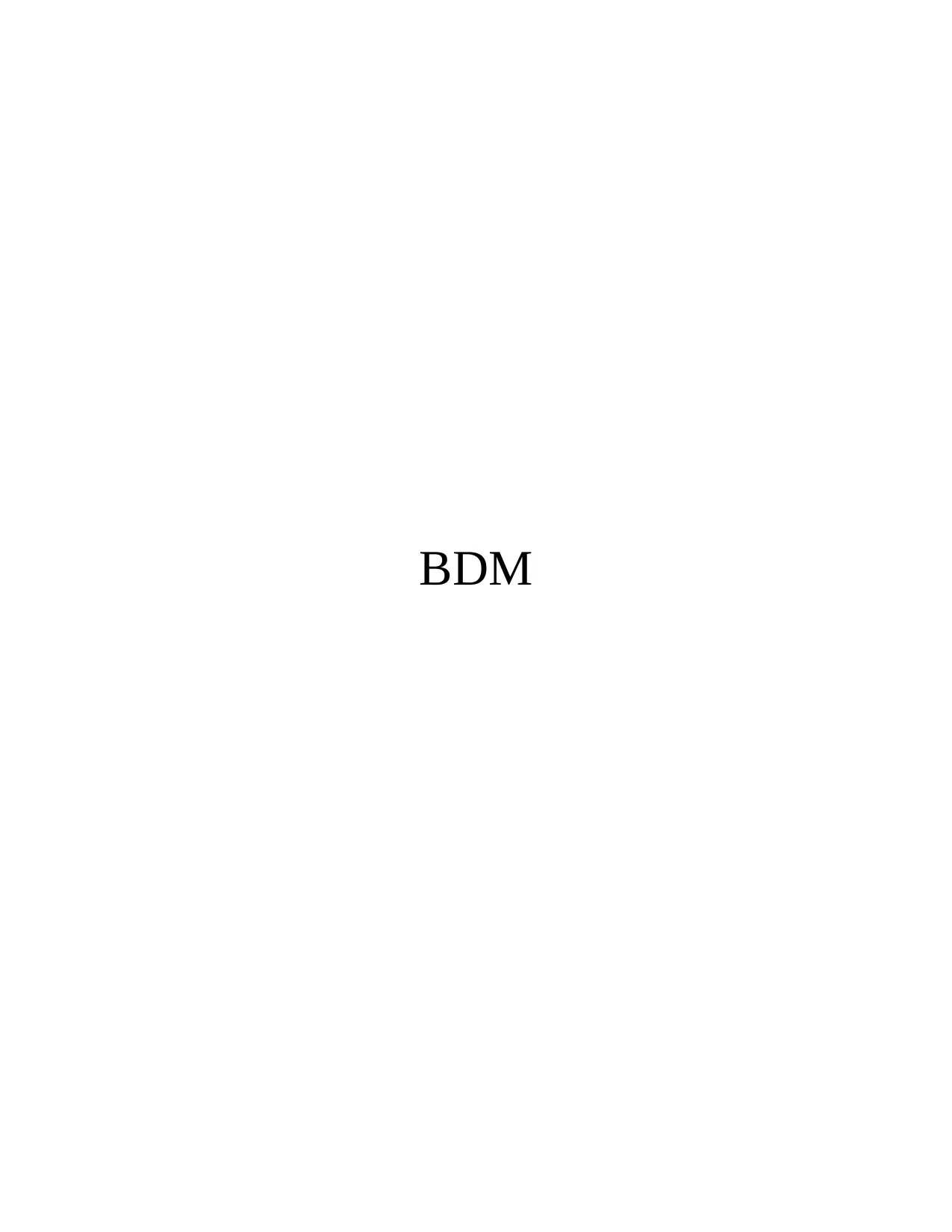
BDM
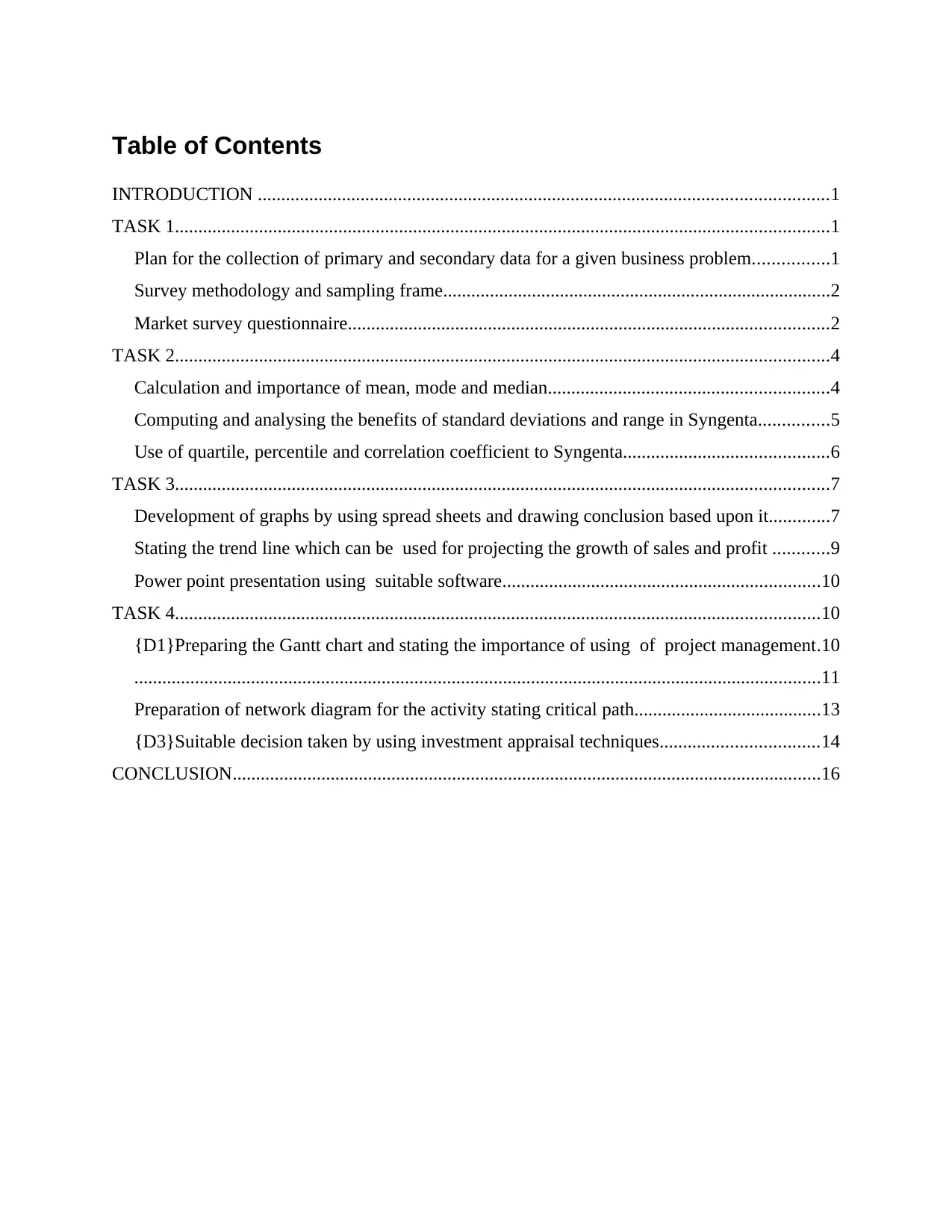
Table of Contents
INTRODUCTION ..........................................................................................................................1
TASK 1............................................................................................................................................1
Plan for the collection of primary and secondary data for a given business problem................1
Survey methodology and sampling frame...................................................................................2
Market survey questionnaire.......................................................................................................2
TASK 2............................................................................................................................................4
Calculation and importance of mean, mode and median............................................................4
Computing and analysing the benefits of standard deviations and range in Syngenta...............5
Use of quartile, percentile and correlation coefficient to Syngenta............................................6
TASK 3............................................................................................................................................7
Development of graphs by using spread sheets and drawing conclusion based upon it.............7
Stating the trend line which can be used for projecting the growth of sales and profit ............9
Power point presentation using suitable software....................................................................10
TASK 4..........................................................................................................................................10
{D1}Preparing the Gantt chart and stating the importance of using of project management.10
...................................................................................................................................................11
Preparation of network diagram for the activity stating critical path........................................13
{D3}Suitable decision taken by using investment appraisal techniques..................................14
CONCLUSION..............................................................................................................................16
INTRODUCTION ..........................................................................................................................1
TASK 1............................................................................................................................................1
Plan for the collection of primary and secondary data for a given business problem................1
Survey methodology and sampling frame...................................................................................2
Market survey questionnaire.......................................................................................................2
TASK 2............................................................................................................................................4
Calculation and importance of mean, mode and median............................................................4
Computing and analysing the benefits of standard deviations and range in Syngenta...............5
Use of quartile, percentile and correlation coefficient to Syngenta............................................6
TASK 3............................................................................................................................................7
Development of graphs by using spread sheets and drawing conclusion based upon it.............7
Stating the trend line which can be used for projecting the growth of sales and profit ............9
Power point presentation using suitable software....................................................................10
TASK 4..........................................................................................................................................10
{D1}Preparing the Gantt chart and stating the importance of using of project management.10
...................................................................................................................................................11
Preparation of network diagram for the activity stating critical path........................................13
{D3}Suitable decision taken by using investment appraisal techniques..................................14
CONCLUSION..............................................................................................................................16
⊘ This is a preview!⊘
Do you want full access?
Subscribe today to unlock all pages.

Trusted by 1+ million students worldwide
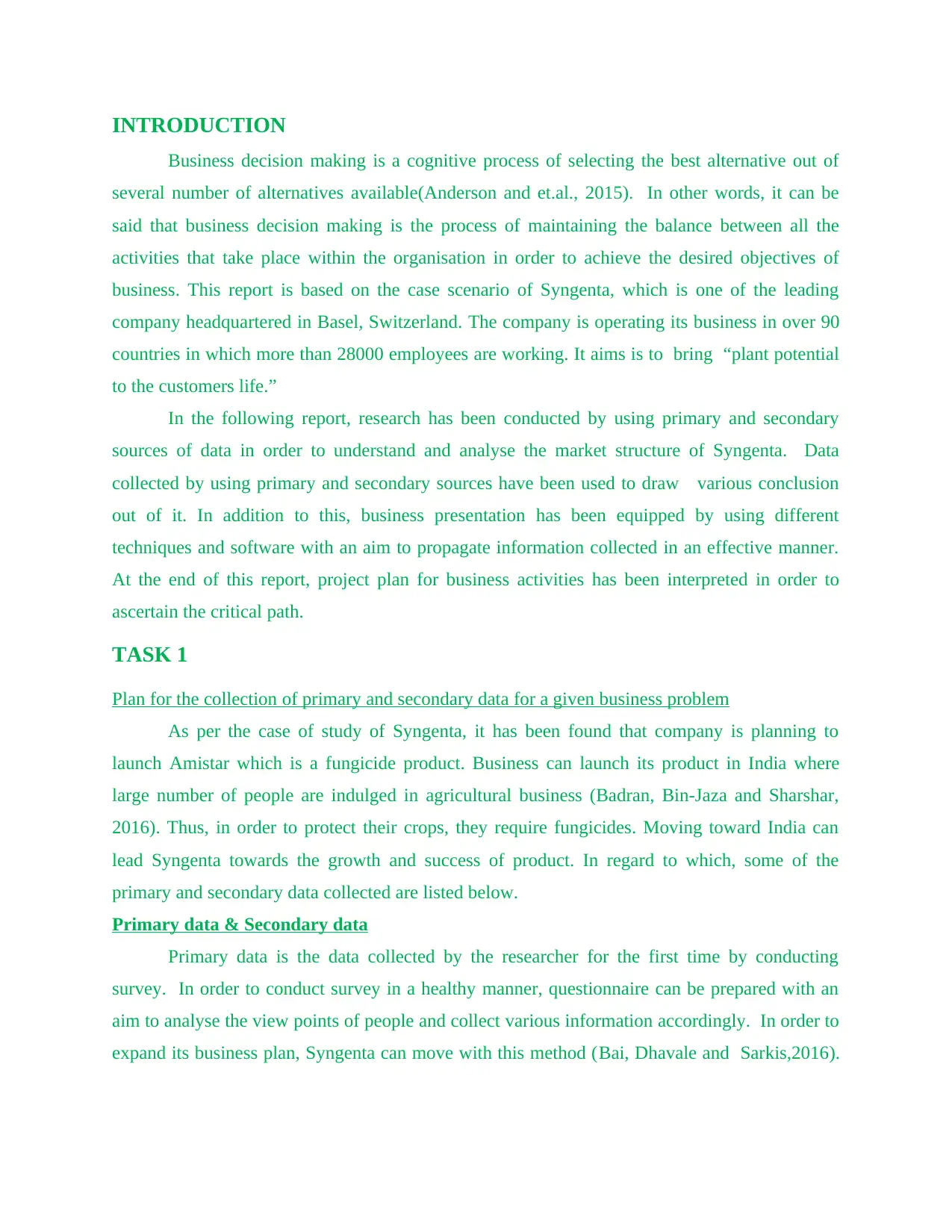
INTRODUCTION
Business decision making is a cognitive process of selecting the best alternative out of
several number of alternatives available(Anderson and et.al., 2015). In other words, it can be
said that business decision making is the process of maintaining the balance between all the
activities that take place within the organisation in order to achieve the desired objectives of
business. This report is based on the case scenario of Syngenta, which is one of the leading
company headquartered in Basel, Switzerland. The company is operating its business in over 90
countries in which more than 28000 employees are working. It aims is to bring “plant potential
to the customers life.”
In the following report, research has been conducted by using primary and secondary
sources of data in order to understand and analyse the market structure of Syngenta. Data
collected by using primary and secondary sources have been used to draw various conclusion
out of it. In addition to this, business presentation has been equipped by using different
techniques and software with an aim to propagate information collected in an effective manner.
At the end of this report, project plan for business activities has been interpreted in order to
ascertain the critical path.
TASK 1
Plan for the collection of primary and secondary data for a given business problem
As per the case of study of Syngenta, it has been found that company is planning to
launch Amistar which is a fungicide product. Business can launch its product in India where
large number of people are indulged in agricultural business (Badran, Bin-Jaza and Sharshar,
2016). Thus, in order to protect their crops, they require fungicides. Moving toward India can
lead Syngenta towards the growth and success of product. In regard to which, some of the
primary and secondary data collected are listed below.
Primary data & Secondary data
Primary data is the data collected by the researcher for the first time by conducting
survey. In order to conduct survey in a healthy manner, questionnaire can be prepared with an
aim to analyse the view points of people and collect various information accordingly. In order to
expand its business plan, Syngenta can move with this method (Bai, Dhavale and Sarkis,2016).
Business decision making is a cognitive process of selecting the best alternative out of
several number of alternatives available(Anderson and et.al., 2015). In other words, it can be
said that business decision making is the process of maintaining the balance between all the
activities that take place within the organisation in order to achieve the desired objectives of
business. This report is based on the case scenario of Syngenta, which is one of the leading
company headquartered in Basel, Switzerland. The company is operating its business in over 90
countries in which more than 28000 employees are working. It aims is to bring “plant potential
to the customers life.”
In the following report, research has been conducted by using primary and secondary
sources of data in order to understand and analyse the market structure of Syngenta. Data
collected by using primary and secondary sources have been used to draw various conclusion
out of it. In addition to this, business presentation has been equipped by using different
techniques and software with an aim to propagate information collected in an effective manner.
At the end of this report, project plan for business activities has been interpreted in order to
ascertain the critical path.
TASK 1
Plan for the collection of primary and secondary data for a given business problem
As per the case of study of Syngenta, it has been found that company is planning to
launch Amistar which is a fungicide product. Business can launch its product in India where
large number of people are indulged in agricultural business (Badran, Bin-Jaza and Sharshar,
2016). Thus, in order to protect their crops, they require fungicides. Moving toward India can
lead Syngenta towards the growth and success of product. In regard to which, some of the
primary and secondary data collected are listed below.
Primary data & Secondary data
Primary data is the data collected by the researcher for the first time by conducting
survey. In order to conduct survey in a healthy manner, questionnaire can be prepared with an
aim to analyse the view points of people and collect various information accordingly. In order to
expand its business plan, Syngenta can move with this method (Bai, Dhavale and Sarkis,2016).
Paraphrase This Document
Need a fresh take? Get an instant paraphrase of this document with our AI Paraphraser
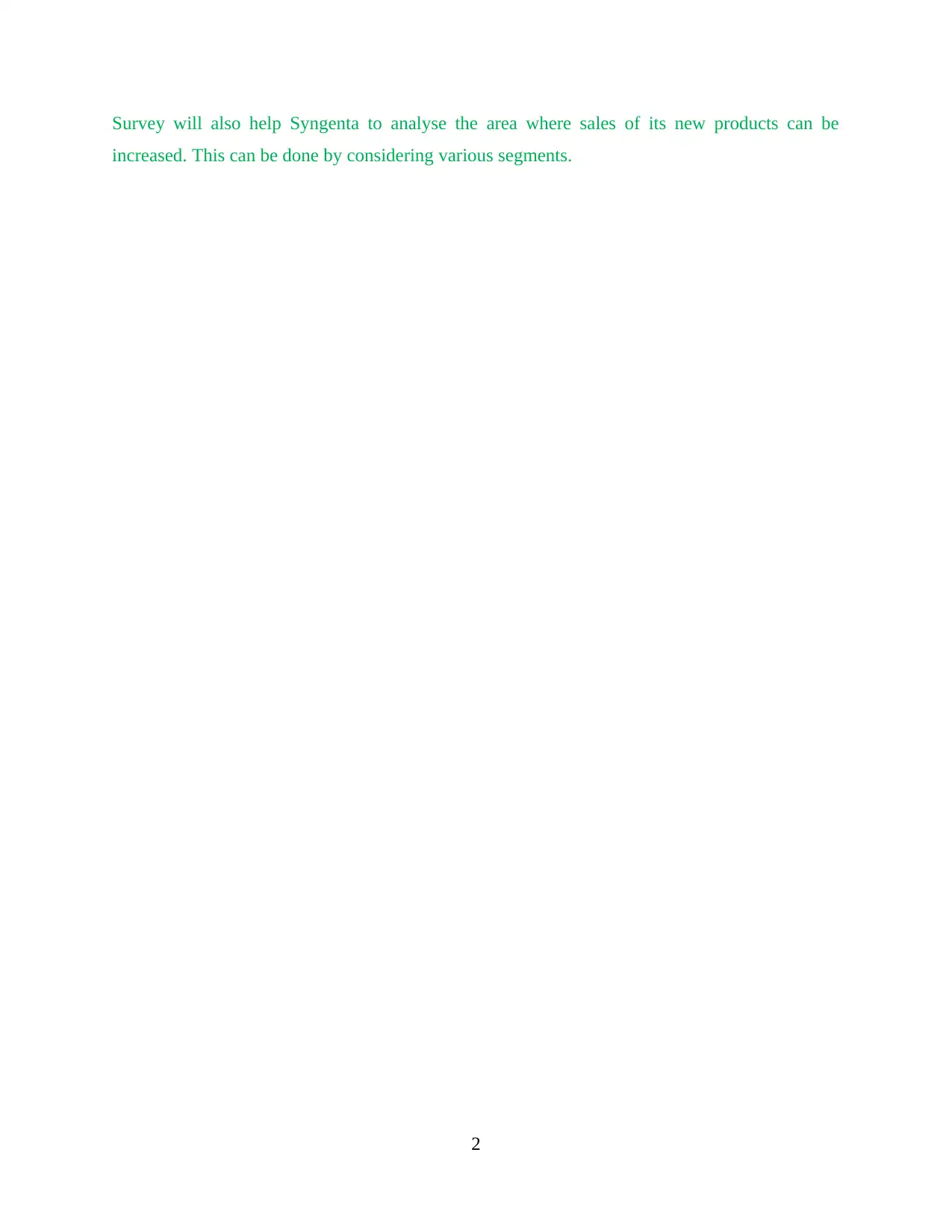
Survey will also help Syngenta to analyse the area where sales of its new products can be
increased. This can be done by considering various segments.
2
increased. This can be done by considering various segments.
2
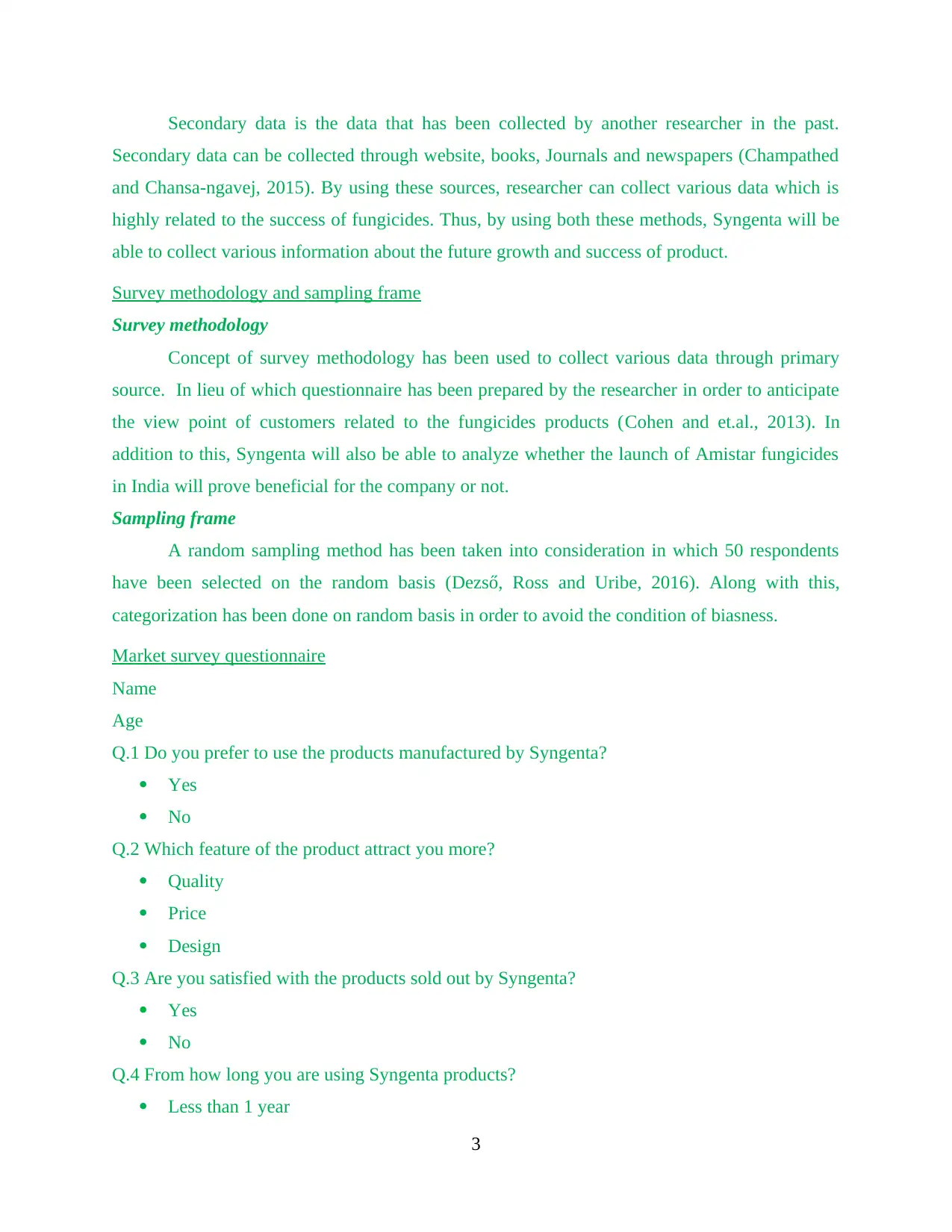
Secondary data is the data that has been collected by another researcher in the past.
Secondary data can be collected through website, books, Journals and newspapers (Champathed
and Chansa-ngavej, 2015). By using these sources, researcher can collect various data which is
highly related to the success of fungicides. Thus, by using both these methods, Syngenta will be
able to collect various information about the future growth and success of product.
Survey methodology and sampling frame
Survey methodology
Concept of survey methodology has been used to collect various data through primary
source. In lieu of which questionnaire has been prepared by the researcher in order to anticipate
the view point of customers related to the fungicides products (Cohen and et.al., 2013). In
addition to this, Syngenta will also be able to analyze whether the launch of Amistar fungicides
in India will prove beneficial for the company or not.
Sampling frame
A random sampling method has been taken into consideration in which 50 respondents
have been selected on the random basis (Dezső, Ross and Uribe, 2016). Along with this,
categorization has been done on random basis in order to avoid the condition of biasness.
Market survey questionnaire
Name
Age
Q.1 Do you prefer to use the products manufactured by Syngenta?
Yes
No
Q.2 Which feature of the product attract you more?
Quality
Price
Design
Q.3 Are you satisfied with the products sold out by Syngenta?
Yes
No
Q.4 From how long you are using Syngenta products?
Less than 1 year
3
Secondary data can be collected through website, books, Journals and newspapers (Champathed
and Chansa-ngavej, 2015). By using these sources, researcher can collect various data which is
highly related to the success of fungicides. Thus, by using both these methods, Syngenta will be
able to collect various information about the future growth and success of product.
Survey methodology and sampling frame
Survey methodology
Concept of survey methodology has been used to collect various data through primary
source. In lieu of which questionnaire has been prepared by the researcher in order to anticipate
the view point of customers related to the fungicides products (Cohen and et.al., 2013). In
addition to this, Syngenta will also be able to analyze whether the launch of Amistar fungicides
in India will prove beneficial for the company or not.
Sampling frame
A random sampling method has been taken into consideration in which 50 respondents
have been selected on the random basis (Dezső, Ross and Uribe, 2016). Along with this,
categorization has been done on random basis in order to avoid the condition of biasness.
Market survey questionnaire
Name
Age
Q.1 Do you prefer to use the products manufactured by Syngenta?
Yes
No
Q.2 Which feature of the product attract you more?
Quality
Price
Design
Q.3 Are you satisfied with the products sold out by Syngenta?
Yes
No
Q.4 From how long you are using Syngenta products?
Less than 1 year
3
⊘ This is a preview!⊘
Do you want full access?
Subscribe today to unlock all pages.

Trusted by 1+ million students worldwide
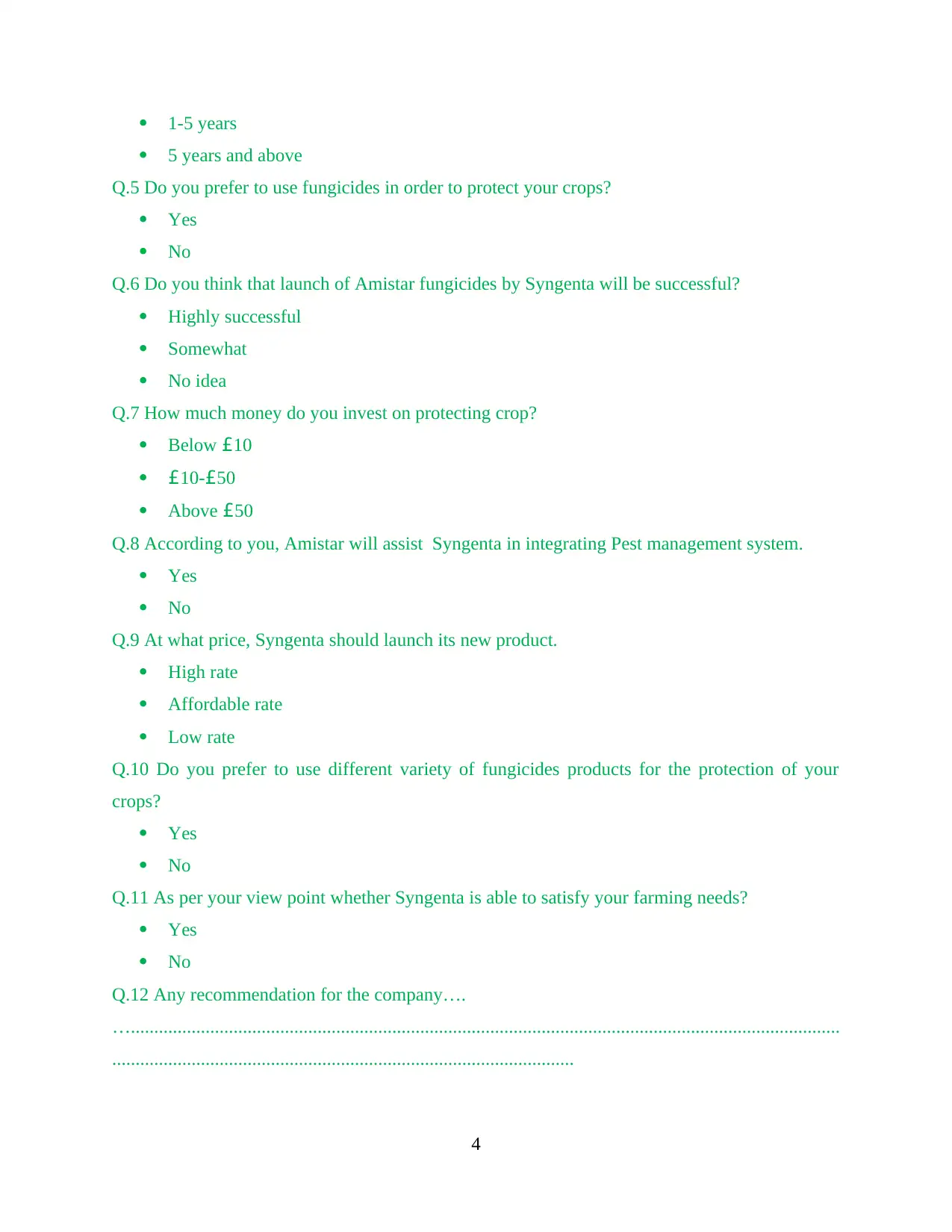
1-5 years
5 years and above
Q.5 Do you prefer to use fungicides in order to protect your crops?
Yes
No
Q.6 Do you think that launch of Amistar fungicides by Syngenta will be successful?
Highly successful
Somewhat
No idea
Q.7 How much money do you invest on protecting crop?
Below £10
£10-£50
Above £50
Q.8 According to you, Amistar will assist Syngenta in integrating Pest management system.
Yes
No
Q.9 At what price, Syngenta should launch its new product.
High rate
Affordable rate
Low rate
Q.10 Do you prefer to use different variety of fungicides products for the protection of your
crops?
Yes
No
Q.11 As per your view point whether Syngenta is able to satisfy your farming needs?
Yes
No
Q.12 Any recommendation for the company….
…........................................................................................................................................................
...................................................................................................
4
5 years and above
Q.5 Do you prefer to use fungicides in order to protect your crops?
Yes
No
Q.6 Do you think that launch of Amistar fungicides by Syngenta will be successful?
Highly successful
Somewhat
No idea
Q.7 How much money do you invest on protecting crop?
Below £10
£10-£50
Above £50
Q.8 According to you, Amistar will assist Syngenta in integrating Pest management system.
Yes
No
Q.9 At what price, Syngenta should launch its new product.
High rate
Affordable rate
Low rate
Q.10 Do you prefer to use different variety of fungicides products for the protection of your
crops?
Yes
No
Q.11 As per your view point whether Syngenta is able to satisfy your farming needs?
Yes
No
Q.12 Any recommendation for the company….
…........................................................................................................................................................
...................................................................................................
4
Paraphrase This Document
Need a fresh take? Get an instant paraphrase of this document with our AI Paraphraser
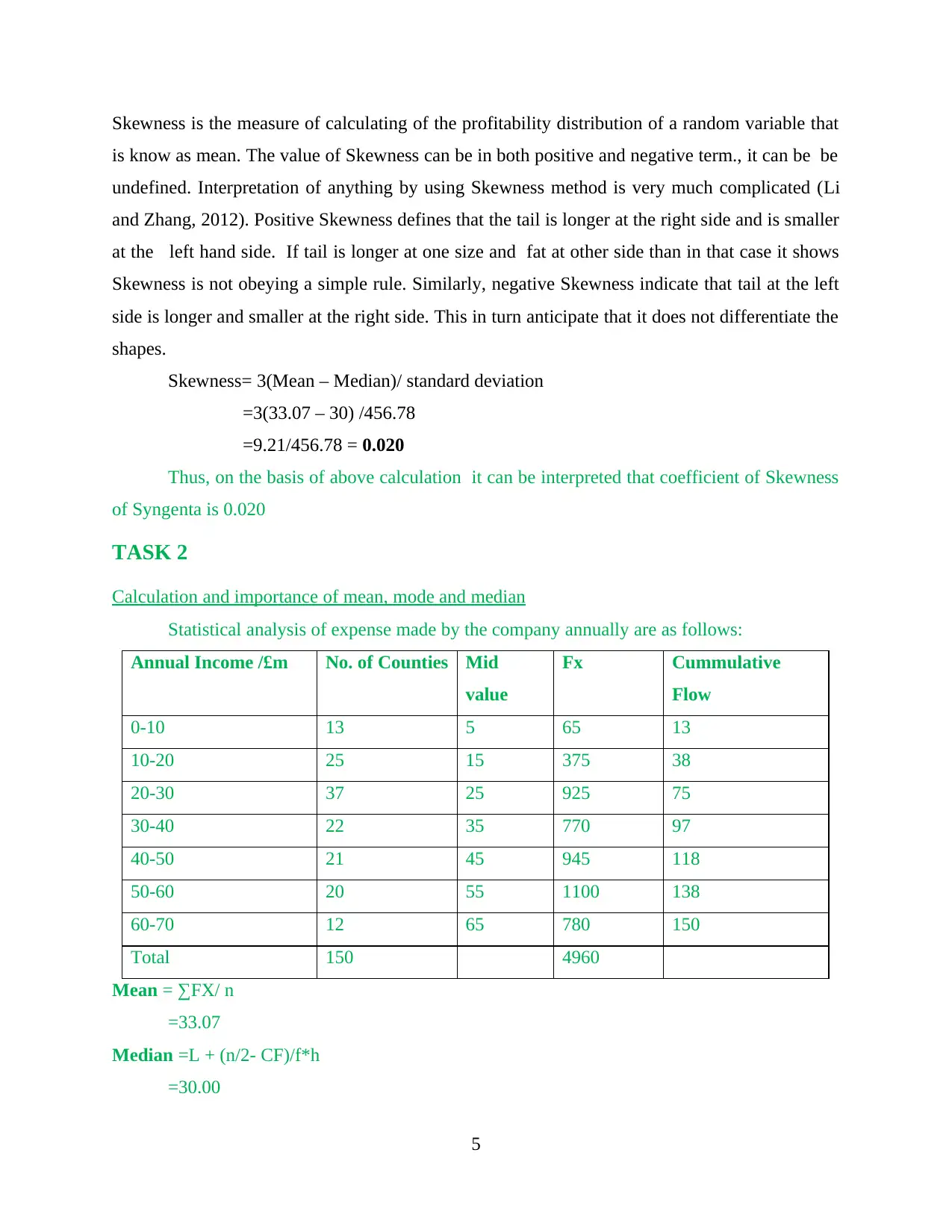
Skewness is the measure of calculating of the profitability distribution of a random variable that
is know as mean. The value of Skewness can be in both positive and negative term., it can be be
undefined. Interpretation of anything by using Skewness method is very much complicated (Li
and Zhang, 2012). Positive Skewness defines that the tail is longer at the right side and is smaller
at the left hand side. If tail is longer at one size and fat at other side than in that case it shows
Skewness is not obeying a simple rule. Similarly, negative Skewness indicate that tail at the left
side is longer and smaller at the right side. This in turn anticipate that it does not differentiate the
shapes.
Skewness= 3(Mean – Median)/ standard deviation
=3(33.07 – 30) /456.78
=9.21/456.78 = 0.020
Thus, on the basis of above calculation it can be interpreted that coefficient of Skewness
of Syngenta is 0.020
TASK 2
Calculation and importance of mean, mode and median
Statistical analysis of expense made by the company annually are as follows:
Annual Income /£m No. of Counties Mid
value
Fx Cummulative
Flow
0-10 13 5 65 13
10-20 25 15 375 38
20-30 37 25 925 75
30-40 22 35 770 97
40-50 21 45 945 118
50-60 20 55 1100 138
60-70 12 65 780 150
Total 150 4960
Mean = ∑FX/ n
=33.07
Median =L + (n/2- CF)/f*h
=30.00
5
is know as mean. The value of Skewness can be in both positive and negative term., it can be be
undefined. Interpretation of anything by using Skewness method is very much complicated (Li
and Zhang, 2012). Positive Skewness defines that the tail is longer at the right side and is smaller
at the left hand side. If tail is longer at one size and fat at other side than in that case it shows
Skewness is not obeying a simple rule. Similarly, negative Skewness indicate that tail at the left
side is longer and smaller at the right side. This in turn anticipate that it does not differentiate the
shapes.
Skewness= 3(Mean – Median)/ standard deviation
=3(33.07 – 30) /456.78
=9.21/456.78 = 0.020
Thus, on the basis of above calculation it can be interpreted that coefficient of Skewness
of Syngenta is 0.020
TASK 2
Calculation and importance of mean, mode and median
Statistical analysis of expense made by the company annually are as follows:
Annual Income /£m No. of Counties Mid
value
Fx Cummulative
Flow
0-10 13 5 65 13
10-20 25 15 375 38
20-30 37 25 925 75
30-40 22 35 770 97
40-50 21 45 945 118
50-60 20 55 1100 138
60-70 12 65 780 150
Total 150 4960
Mean = ∑FX/ n
=33.07
Median =L + (n/2- CF)/f*h
=30.00
5
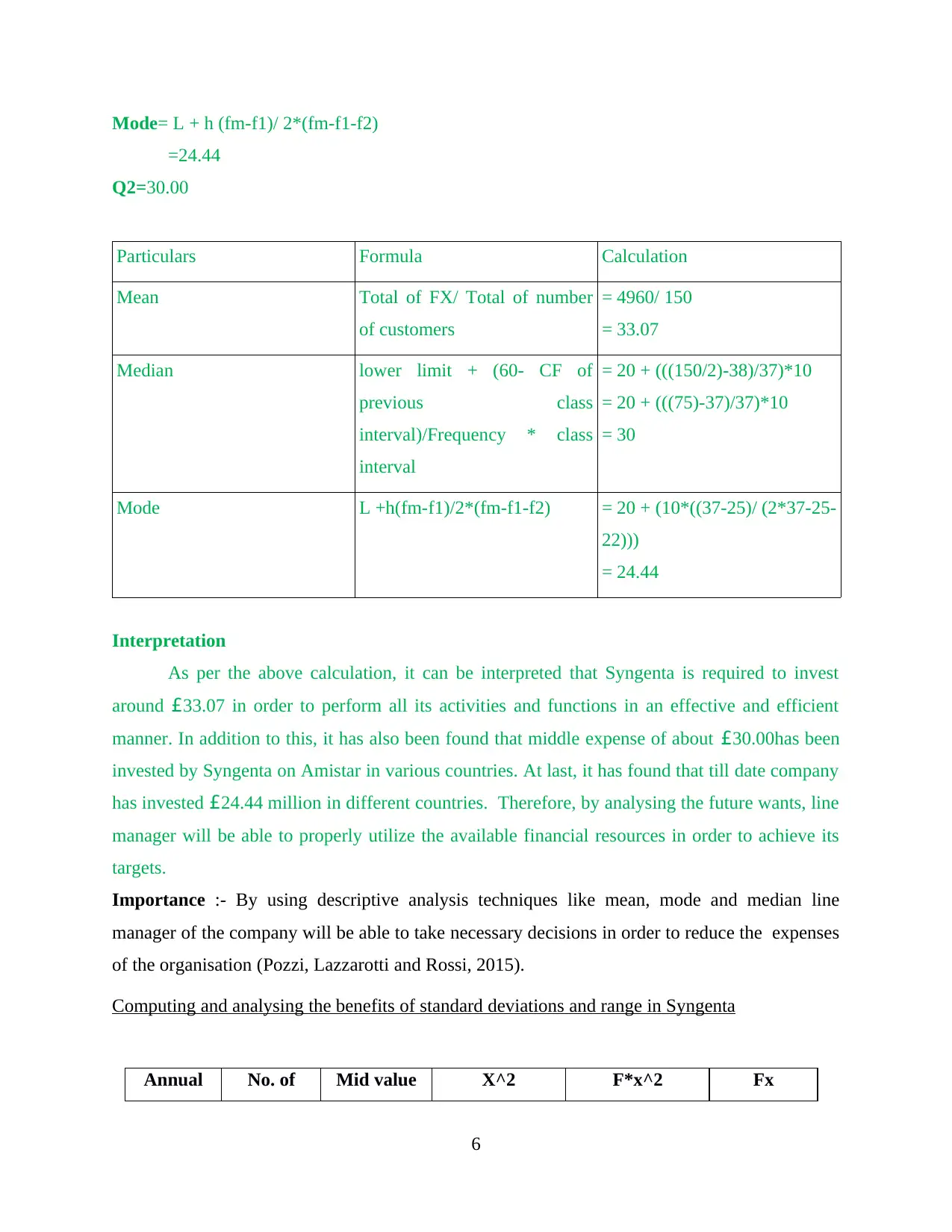
Mode= L + h (fm-f1)/ 2*(fm-f1-f2)
=24.44
Q2=30.00
Particulars Formula Calculation
Mean Total of FX/ Total of number
of customers
= 4960/ 150
= 33.07
Median lower limit + (60- CF of
previous class
interval)/Frequency * class
interval
= 20 + (((150/2)-38)/37)*10
= 20 + (((75)-37)/37)*10
= 30
Mode L +h(fm-f1)/2*(fm-f1-f2) = 20 + (10*((37-25)/ (2*37-25-
22)))
= 24.44
Interpretation
As per the above calculation, it can be interpreted that Syngenta is required to invest
around £33.07 in order to perform all its activities and functions in an effective and efficient
manner. In addition to this, it has also been found that middle expense of about £30.00has been
invested by Syngenta on Amistar in various countries. At last, it has found that till date company
has invested £24.44 million in different countries. Therefore, by analysing the future wants, line
manager will be able to properly utilize the available financial resources in order to achieve its
targets.
Importance :- By using descriptive analysis techniques like mean, mode and median line
manager of the company will be able to take necessary decisions in order to reduce the expenses
of the organisation (Pozzi, Lazzarotti and Rossi, 2015).
Computing and analysing the benefits of standard deviations and range in Syngenta
Annual No. of Mid value X^2 F*x^2 Fx
6
=24.44
Q2=30.00
Particulars Formula Calculation
Mean Total of FX/ Total of number
of customers
= 4960/ 150
= 33.07
Median lower limit + (60- CF of
previous class
interval)/Frequency * class
interval
= 20 + (((150/2)-38)/37)*10
= 20 + (((75)-37)/37)*10
= 30
Mode L +h(fm-f1)/2*(fm-f1-f2) = 20 + (10*((37-25)/ (2*37-25-
22)))
= 24.44
Interpretation
As per the above calculation, it can be interpreted that Syngenta is required to invest
around £33.07 in order to perform all its activities and functions in an effective and efficient
manner. In addition to this, it has also been found that middle expense of about £30.00has been
invested by Syngenta on Amistar in various countries. At last, it has found that till date company
has invested £24.44 million in different countries. Therefore, by analysing the future wants, line
manager will be able to properly utilize the available financial resources in order to achieve its
targets.
Importance :- By using descriptive analysis techniques like mean, mode and median line
manager of the company will be able to take necessary decisions in order to reduce the expenses
of the organisation (Pozzi, Lazzarotti and Rossi, 2015).
Computing and analysing the benefits of standard deviations and range in Syngenta
Annual No. of Mid value X^2 F*x^2 Fx
6
⊘ This is a preview!⊘
Do you want full access?
Subscribe today to unlock all pages.

Trusted by 1+ million students worldwide
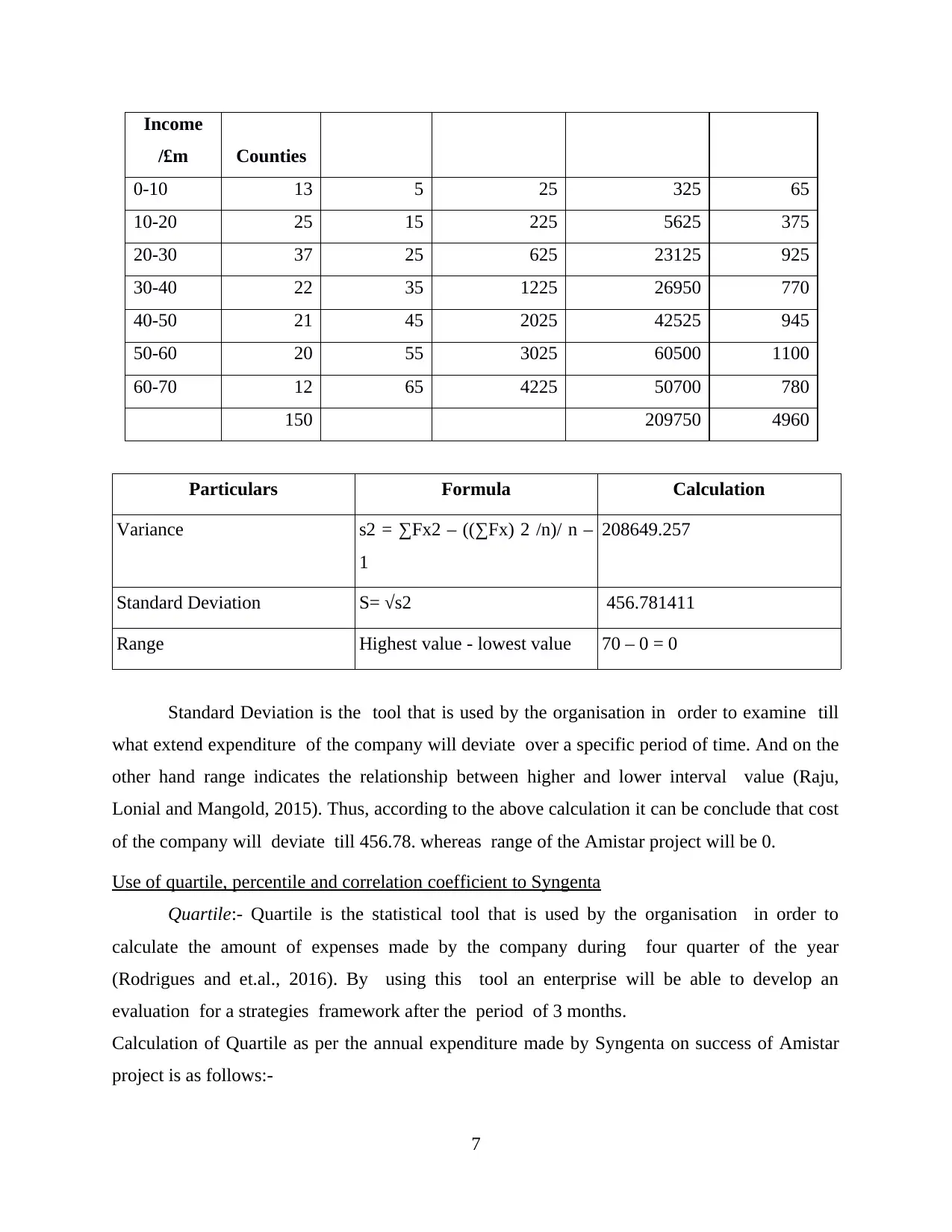
Income
/£m Counties
0-10 13 5 25 325 65
10-20 25 15 225 5625 375
20-30 37 25 625 23125 925
30-40 22 35 1225 26950 770
40-50 21 45 2025 42525 945
50-60 20 55 3025 60500 1100
60-70 12 65 4225 50700 780
150 209750 4960
Particulars Formula Calculation
Variance s2 = ∑Fx2 – ((∑Fx) 2 /n)/ n –
1
208649.257
Standard Deviation S= √s2 456.781411
Range Highest value - lowest value 70 – 0 = 0
Standard Deviation is the tool that is used by the organisation in order to examine till
what extend expenditure of the company will deviate over a specific period of time. And on the
other hand range indicates the relationship between higher and lower interval value (Raju,
Lonial and Mangold, 2015). Thus, according to the above calculation it can be conclude that cost
of the company will deviate till 456.78. whereas range of the Amistar project will be 0.
Use of quartile, percentile and correlation coefficient to Syngenta
Quartile:- Quartile is the statistical tool that is used by the organisation in order to
calculate the amount of expenses made by the company during four quarter of the year
(Rodrigues and et.al., 2016). By using this tool an enterprise will be able to develop an
evaluation for a strategies framework after the period of 3 months.
Calculation of Quartile as per the annual expenditure made by Syngenta on success of Amistar
project is as follows:-
7
/£m Counties
0-10 13 5 25 325 65
10-20 25 15 225 5625 375
20-30 37 25 625 23125 925
30-40 22 35 1225 26950 770
40-50 21 45 2025 42525 945
50-60 20 55 3025 60500 1100
60-70 12 65 4225 50700 780
150 209750 4960
Particulars Formula Calculation
Variance s2 = ∑Fx2 – ((∑Fx) 2 /n)/ n –
1
208649.257
Standard Deviation S= √s2 456.781411
Range Highest value - lowest value 70 – 0 = 0
Standard Deviation is the tool that is used by the organisation in order to examine till
what extend expenditure of the company will deviate over a specific period of time. And on the
other hand range indicates the relationship between higher and lower interval value (Raju,
Lonial and Mangold, 2015). Thus, according to the above calculation it can be conclude that cost
of the company will deviate till 456.78. whereas range of the Amistar project will be 0.
Use of quartile, percentile and correlation coefficient to Syngenta
Quartile:- Quartile is the statistical tool that is used by the organisation in order to
calculate the amount of expenses made by the company during four quarter of the year
(Rodrigues and et.al., 2016). By using this tool an enterprise will be able to develop an
evaluation for a strategies framework after the period of 3 months.
Calculation of Quartile as per the annual expenditure made by Syngenta on success of Amistar
project is as follows:-
7
Paraphrase This Document
Need a fresh take? Get an instant paraphrase of this document with our AI Paraphraser
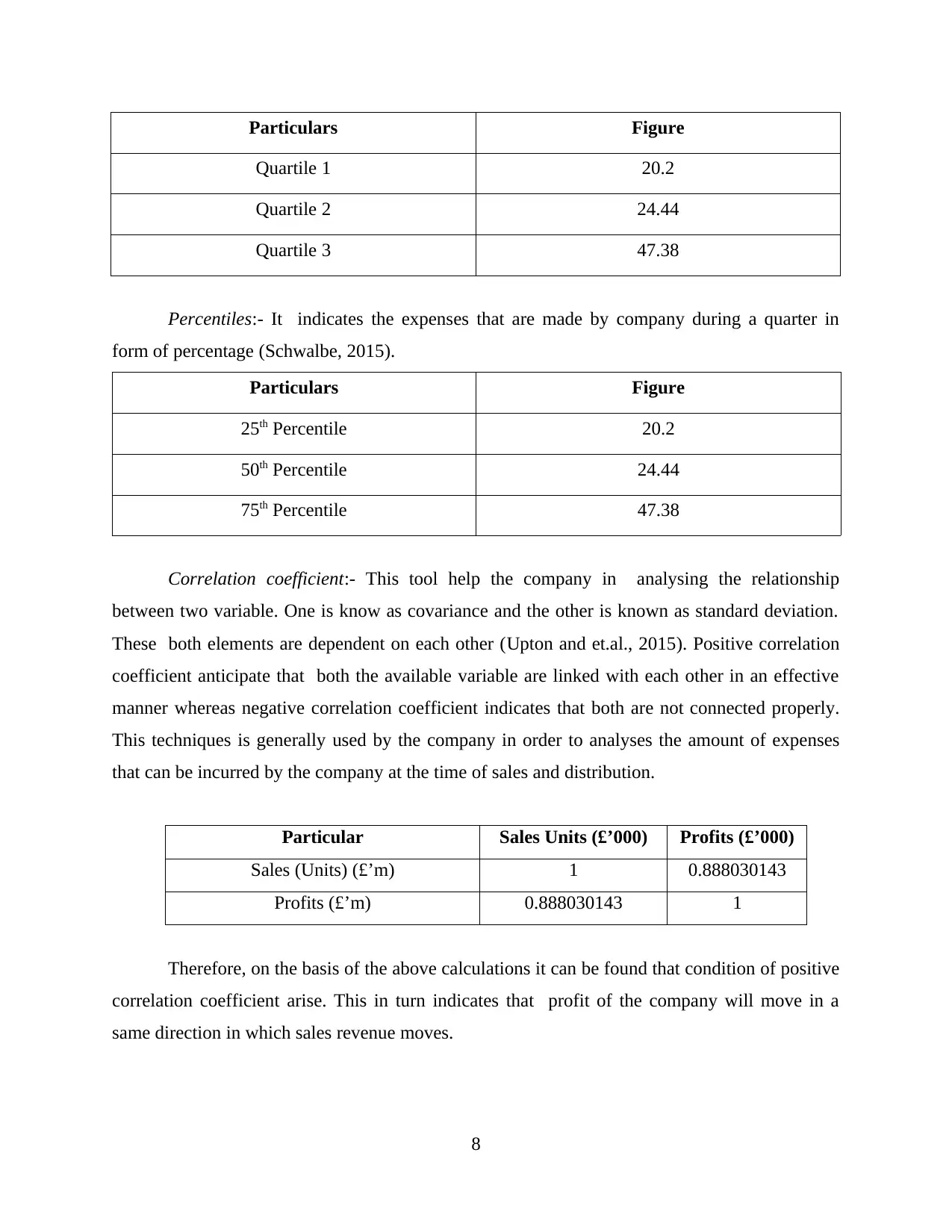
Particulars Figure
Quartile 1 20.2
Quartile 2 24.44
Quartile 3 47.38
Percentiles:- It indicates the expenses that are made by company during a quarter in
form of percentage (Schwalbe, 2015).
Particulars Figure
25th Percentile 20.2
50th Percentile 24.44
75th Percentile 47.38
Correlation coefficient:- This tool help the company in analysing the relationship
between two variable. One is know as covariance and the other is known as standard deviation.
These both elements are dependent on each other (Upton and et.al., 2015). Positive correlation
coefficient anticipate that both the available variable are linked with each other in an effective
manner whereas negative correlation coefficient indicates that both are not connected properly.
This techniques is generally used by the company in order to analyses the amount of expenses
that can be incurred by the company at the time of sales and distribution.
Particular Sales Units (£’000) Profits (£’000)
Sales (Units) (£’m) 1 0.888030143
Profits (£’m) 0.888030143 1
Therefore, on the basis of the above calculations it can be found that condition of positive
correlation coefficient arise. This in turn indicates that profit of the company will move in a
same direction in which sales revenue moves.
8
Quartile 1 20.2
Quartile 2 24.44
Quartile 3 47.38
Percentiles:- It indicates the expenses that are made by company during a quarter in
form of percentage (Schwalbe, 2015).
Particulars Figure
25th Percentile 20.2
50th Percentile 24.44
75th Percentile 47.38
Correlation coefficient:- This tool help the company in analysing the relationship
between two variable. One is know as covariance and the other is known as standard deviation.
These both elements are dependent on each other (Upton and et.al., 2015). Positive correlation
coefficient anticipate that both the available variable are linked with each other in an effective
manner whereas negative correlation coefficient indicates that both are not connected properly.
This techniques is generally used by the company in order to analyses the amount of expenses
that can be incurred by the company at the time of sales and distribution.
Particular Sales Units (£’000) Profits (£’000)
Sales (Units) (£’m) 1 0.888030143
Profits (£’m) 0.888030143 1
Therefore, on the basis of the above calculations it can be found that condition of positive
correlation coefficient arise. This in turn indicates that profit of the company will move in a
same direction in which sales revenue moves.
8
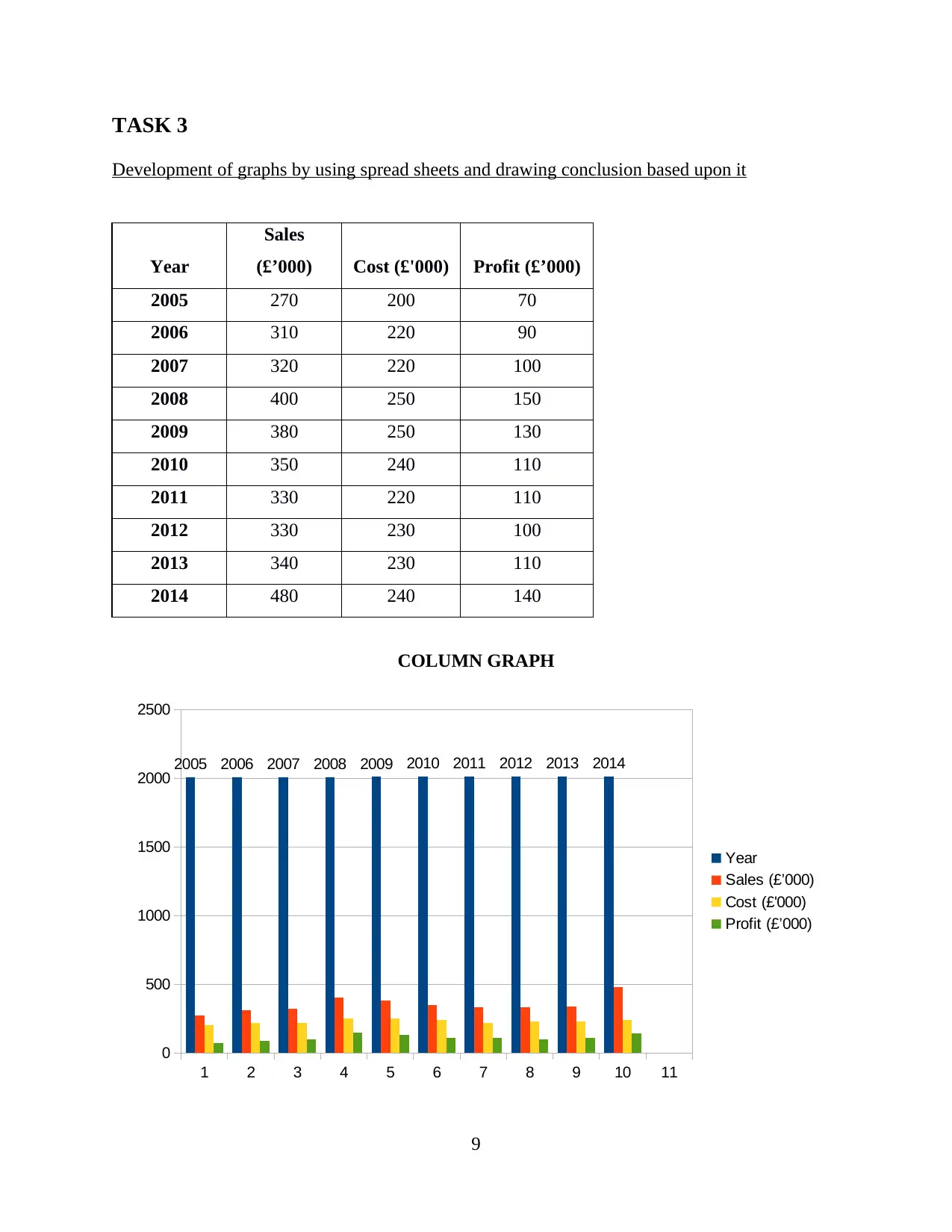
TASK 3
Development of graphs by using spread sheets and drawing conclusion based upon it
Year
Sales
(£’000) Cost (£'000) Profit (£’000)
2005 270 200 70
2006 310 220 90
2007 320 220 100
2008 400 250 150
2009 380 250 130
2010 350 240 110
2011 330 220 110
2012 330 230 100
2013 340 230 110
2014 480 240 140
COLUMN GRAPH
9
1 2 3 4 5 6 7 8 9 10 11
0
500
1000
1500
2000
2500
2005 2006 2007 2008 2009 2010 2011 2012 2013 2014
Year
Sales (£’000)
Cost (£'000)
Profit (£’000)
Development of graphs by using spread sheets and drawing conclusion based upon it
Year
Sales
(£’000) Cost (£'000) Profit (£’000)
2005 270 200 70
2006 310 220 90
2007 320 220 100
2008 400 250 150
2009 380 250 130
2010 350 240 110
2011 330 220 110
2012 330 230 100
2013 340 230 110
2014 480 240 140
COLUMN GRAPH
9
1 2 3 4 5 6 7 8 9 10 11
0
500
1000
1500
2000
2500
2005 2006 2007 2008 2009 2010 2011 2012 2013 2014
Year
Sales (£’000)
Cost (£'000)
Profit (£’000)
⊘ This is a preview!⊘
Do you want full access?
Subscribe today to unlock all pages.

Trusted by 1+ million students worldwide
1 out of 22
Related Documents
Your All-in-One AI-Powered Toolkit for Academic Success.
+13062052269
info@desklib.com
Available 24*7 on WhatsApp / Email
![[object Object]](/_next/static/media/star-bottom.7253800d.svg)
Unlock your academic potential
Copyright © 2020–2025 A2Z Services. All Rights Reserved. Developed and managed by ZUCOL.





